
Scutus is a genus of large sea snails or limpets with the common name "shield shells". These are marine gastropod molluscs in the family Fissurellidae, the keyhole limpets and slit limpets.
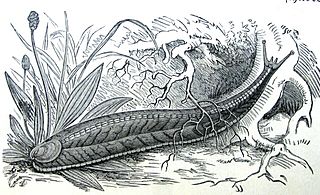
Testacella is genus of small to medium-large, predatory, air-breathing, land slugs.
Pithecellobium unguis-cati is a species of plant in the family Fabaceae. It ranges from Mexico through Central America and the Caribbean to Colombia, Venezuela, and Florida. It is known by many synonyms.

Teinostoma is a genus of minute sea snails, marine gastropod mollusks or micromollusks in the family Teinostomatidae.
Stenostomum radiatum, synonym Antirhea radiata, is a species of plant in the family Rubiaceae. It is found in Cuba and Haiti. It is threatened by habitat loss.

Heterococcus is a genus of yellow-green algae (xanthophytes) in the family Heteropediaceae. It is the only xanthophyte genus known to form lichens.
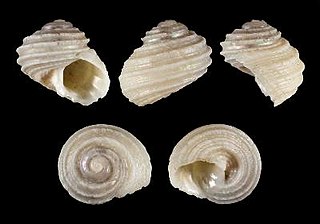
Homalopoma, common name the dwarf turbans, is a genus of mostly very small sea snails with a calcareous operculum, marine gastropoda molluscs in the subfamily Colloniinae of the family Colloniidae.

Concholepas is a genus of medium-sized to large predatory sea snails, marine gastropod mollusks in the family Muricidae, the rock shells.
Pterygium inversum unguis or ventral pterygium is characterized by the adherence of the distal portion of the nailbed to the ventral surface of the nail plate. The condition may be present at birth or acquired, and may cause pain with manipulation of small objects, typing, and close manicuring of the nail. secondary due to connective tissue disorders. Pterygium inversum unguis is often asymptomatic.

Pilina unguis is an extinct species of Paleozoic Silurian monoplacophoran. It was first named as Tryblidium unguis and described by Gustaf Lindström in Latin from the Silurian deposits of Gotland in Sweden, in 1880.

Pilina is an extinct genus of paleozoic monoplacophorans in the family Tryblidiidae.

Helcionopsis radiatum is an extinct species of paleozoic monoplacophoran in the family Tryblidiidae.

Helcionopsis is an extinct genus of paleozoic monoplacophoran in the family Tryblidiidae.

Astraea is a genus of medium to large sea snails, marine gastropod mollusks in the family Turbinidae, the turban snails.
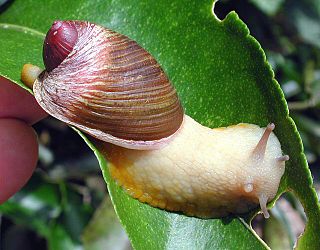
Amphibulima is a genus of air-breathing land snails, a terrestrial pulmonate gastropod mollusks in the family Amphibulimidae.
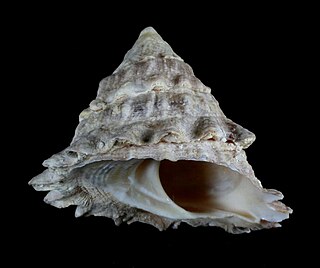
Uvanilla is a genus of sea snails, marine gastropod mollusks in the family Turbinidae, the turban snails.

Glyptagnostus reticulatus is a species of agnostid trilobite belonging to the genus Glyptagnostus. It existed during the Paibian Age of the Cambrian. It has a cosmopolitan distribution and is an important index fossil in biostratigraphy. It was characterized by an unusual net-like pattern of furrows on both the cephalon and the pygidium.
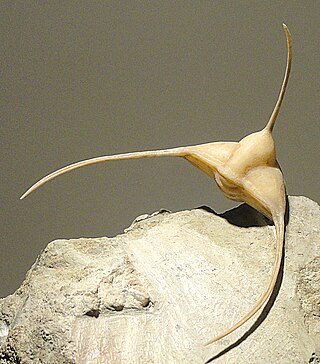
Raphiophoridae is a family of small to average-sized trilobites that first occurred at the start of the Ordovician and became extinct at the end of the Middle Silurian.
Aspergillus unguis is a species of fungus in the genus Aspergillus, and the asexual state (anamorph) of Emericella unguis. Aspergillus unguis is a filamentous soil-borne fungus found on decomposing plant matter and other moist substrates including with building materials and household dust. Aspergillus unguis occurs mainly in tropical and subtropical soils but has also been isolated from various marine and aquatic habitats. The species was first isolated in 1935 by Weill and L. Gaudin. Historically, A. unguis was assigned to the A. nidulans group, a common group of soil-borne fungi due to the resemblance of its ascospores and cleistothecia to those of Emericella nidulans. Aspergillus unguis is distinctive, however, in possessing spicular hyphae. A number of synonyms have been collapsed into this species, including Sterigmatocystis unguis, Aspergillus laokiashanensis and Aspergillus mellinus.

Omalonyx unguis is a species of air-breathing land snail, a terrestrial pulmonate gastropod mollusc in the family Succineidae, the amber snails.














